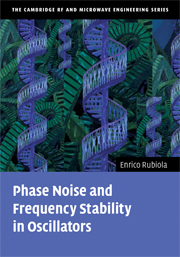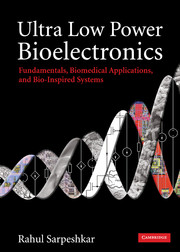Refine search
Actions for selected content:
1562 results in RF and microwave engineering
15 - Finite volume and finite element methods
-
- Book:
- Numerical Electromagnetics
- Published online:
- 05 June 2012
- Print publication:
- 07 April 2011, pp 356-384
-
- Chapter
- Export citation
3 - Partial differential equations and physical systems
-
- Book:
- Numerical Electromagnetics
- Published online:
- 05 June 2012
- Print publication:
- 07 April 2011, pp 34-71
-
- Chapter
- Export citation
Contents
-
- Book:
- Numerical Electromagnetics
- Published online:
- 05 June 2012
- Print publication:
- 07 April 2011, pp vii-xii
-
- Chapter
- Export citation

Electromagnetics for High-Speed Analog and Digital Communication Circuits
-
- Published online:
- 17 March 2011
- Print publication:
- 22 February 2007

Phase Noise and Frequency Stability in Oscillators
-
- Published online:
- 24 January 2011
- Print publication:
- 13 November 2008

Ultra Low Power Bioelectronics
- Fundamentals, Biomedical Applications, and Bio-Inspired Systems
-
- Published online:
- 02 December 2010
- Print publication:
- 22 February 2010
Acknowledgements
-
- Book:
- Computational Electromagnetics for RF and Microwave Engineering
- Published online:
- 05 July 2014
- Print publication:
- 28 October 2010, pp xxi-xxii
-
- Chapter
- Export citation
12 - A selection of more advanced topics in full-wave computational electromagnetics
-
- Book:
- Computational Electromagnetics for RF and Microwave Engineering
- Published online:
- 05 July 2014
- Print publication:
- 28 October 2010, pp 451-483
-
- Chapter
- Export citation
List of notation
-
- Book:
- Computational Electromagnetics for RF and Microwave Engineering
- Published online:
- 05 July 2014
- Print publication:
- 28 October 2010, pp xxiv-xxiv
-
- Chapter
- Export citation
Dedication
-
- Book:
- Computational Electromagnetics for RF and Microwave Engineering
- Published online:
- 05 July 2014
- Print publication:
- 28 October 2010, pp v-vi
-
- Chapter
- Export citation
10 - The finite element method in two dimensions: scalar and vector elements
-
- Book:
- Computational Electromagnetics for RF and Microwave Engineering
- Published online:
- 05 July 2014
- Print publication:
- 28 October 2010, pp 342-406
-
- Chapter
- Export citation
Frontmatter
-
- Book:
- Computational Electromagnetics for RF and Microwave Engineering
- Published online:
- 05 July 2014
- Print publication:
- 28 October 2010, pp i-iv
-
- Chapter
- Export citation
Preface to the first edition
-
- Book:
- Computational Electromagnetics for RF and Microwave Engineering
- Published online:
- 05 July 2014
- Print publication:
- 28 October 2010, pp xvii-xx
-
- Chapter
- Export citation
Appendix F - MATLAB files supporting this text
-
- Book:
- Computational Electromagnetics for RF and Microwave Engineering
- Published online:
- 05 July 2014
- Print publication:
- 28 October 2010, pp 496-497
-
- Chapter
- Export citation
Index
-
- Book:
- Computational Electromagnetics for RF and Microwave Engineering
- Published online:
- 05 July 2014
- Print publication:
- 28 October 2010, pp 498-505
-
- Chapter
- Export citation
11 - The finite element method in three dimensions
-
- Book:
- Computational Electromagnetics for RF and Microwave Engineering
- Published online:
- 05 July 2014
- Print publication:
- 28 October 2010, pp 407-450
-
- Chapter
- Export citation
3 - The finite difference time domain method in two and three dimensions
-
- Book:
- Computational Electromagnetics for RF and Microwave Engineering
- Published online:
- 05 July 2014
- Print publication:
- 28 October 2010, pp 74-129
-
- Chapter
- Export citation
1 - An overview of computational electromagnetics for RF and microwave applications
-
- Book:
- Computational Electromagnetics for RF and Microwave Engineering
- Published online:
- 05 July 2014
- Print publication:
- 28 October 2010, pp 1-31
-
- Chapter
- Export citation
Appendix B - The Newmark-β time-stepping algorithm References
-
- Book:
- Computational Electromagnetics for RF and Microwave Engineering
- Published online:
- 05 July 2014
- Print publication:
- 28 October 2010, pp 486-488
-
- Chapter
- Export citation
Contents
-
- Book:
- Computational Electromagnetics for RF and Microwave Engineering
- Published online:
- 05 July 2014
- Print publication:
- 28 October 2010, pp vii-xiv
-
- Chapter
- Export citation
